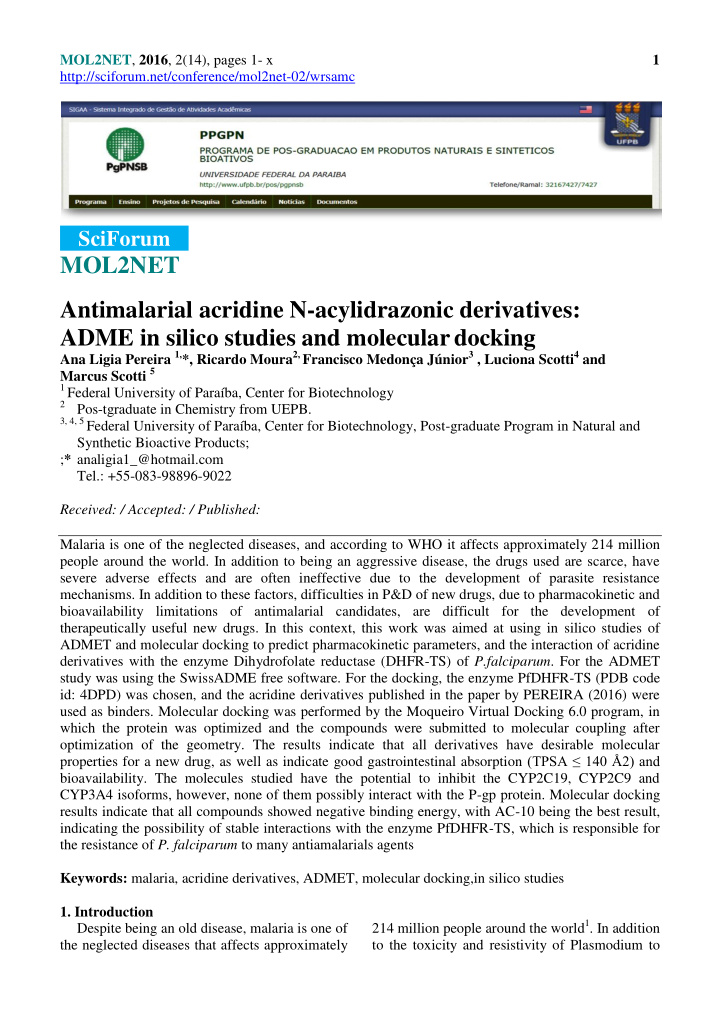



MOL2NET , 2016 , 2(14), pages 1- x 1 http://sciforum.net/conference/mol2net-02/wrsamc SciForum MOL2NET Antimalarial acridine N-acylidrazonic derivatives: ADME in silico studies and molecular docking Ana Ligia Pereira 1, *, Ricardo Moura 2, Francisco Medonça Júnior 3 , Luciona Scotti 4 and Marcus Scotti 5 1 Federal University of Paraíba, Center for Biotechnology 2 Pos-tgraduate in Chemistry from UEPB. 3, 4, 5 Federal University of Paraíba, Center for Biotechnology, Post-graduate Program in Natural and Synthetic Bioactive Products; ; * analigia1_@hotmail.com Tel.: +55-083-98896-9022 Received: / Accepted: / Published: Malaria is one of the neglected diseases, and according to WHO it affects approximately 214 million people around the world. In addition to being an aggressive disease, the drugs used are scarce, have severe adverse effects and are often ineffective due to the development of parasite resistance mechanisms. In addition to these factors, difficulties in P&D of new drugs, due to pharmacokinetic and bioavailability limitations of antimalarial candidates, are difficult for the development of therapeutically useful new drugs. In this context, this work was aimed at using in silico studies of ADMET and molecular docking to predict pharmacokinetic parameters, and the interaction of acridine derivatives with the enzyme Dihydrofolate reductase (DHFR-TS) of P.falciparum . For the ADMET study was using the SwissADME free software. For the docking, the enzyme PfDHFR-TS (PDB code id: 4DPD) was chosen, and the acridine derivatives published in the paper by PEREIRA (2016) were used as binders. Molecular docking was performed by the Moqueiro Virtual Docking 6.0 program, in which the protein was optimized and the compounds were submitted to molecular coupling after optimization of the geometry. The results indicate that all derivatives have desirable molecular properties for a new drug, as well as indicate good gastrointestinal absorption (TPSA ≤ 140 Å2) and bioavailability. The molecules studied have the potential to inhibit the CYP2C19, CYP2C9 and CYP3A4 isoforms, however, none of them possibly interact with the P-gp protein. Molecular docking results indicate that all compounds showed negative binding energy, with AC-10 being the best result, indicating the possibility of stable interactions with the enzyme PfDHFR-TS, which is responsible for the resistance of P. falciparum to many antiamalarials agents Keywords: malaria, acridine derivatives, ADMET, molecular docking,in silico studies 1. Introduction 214 million people around the world 1 . In addition Despite being an old disease, malaria is one of the neglected diseases that affects approximately to the toxicity and resistivity of Plasmodium to
Mol2Net , 2015 , 1(Section A, B, C, etc.), 1- x, type of paper, doi: xxx-xxxx 2 antimalarials, the P&D process of new drugs is also a problem for the creation of new 2. Results and Discussion antimalarials due to the problems of Furthermore, as shown in Table 2 the acridine pharmacokinetics and detection of toxic effects derivatives studied inhibited CYP2C19, CYP2C9 and (CALIXTO; SIQUEIRA, 2008). CYP3A4 isoforms. Among them, CAs 01, 04 and 05 Among the recent strategies to repair these should be highlighted, since they do not interact with problems are in silico studies, such as the all isoforms, and consequently can present better docking molecule and the ADMET, which have efficiency and lower toxicity 7 . The possible lack of as main advantages the reduction of time interaction with P-gp (glycoprotein-P) is also expenditures and investments in biological satisfactory, since interactions with this glycoprotein assays of derivatives with high probability of may decrease the therapeutic efficacy or potentiate pharmacokinetic and toxic problems in the toxic side effects 8 . future 3 . When analyzing the graphs of Bioavaliality Radar Due to its reputation as a privileged sturgeon, it is observed that the compost AC-12 can present a as well as its wide biological action, mainly for . neglected diseases such as malaria 4 , acridine better bioavailability profile of the evaluated . compost, once all the parameters are in the pink area derivatives are excellent candidates for in silico . (figure 1). On the other hand, compost AC-05 is the studies. . one that can present less satisfactory results for this Thus, the main purpose of the present work is . item (Figure 1). to predict by means of in silico studies . parameters of ADME, and to evaluate the best . 2.2 Docking molecular with PfDHFR-TS ligands of the enzyme PfDHFR-TS, of new . enzyme acridine derivatives. Knowing the importance of the enzyme PfDHFR- 2.1 ADME in silico studies TS in the process of antimalarial resistance by P. falciparum 9 , the molecular docking of this enzyme According to table 1, all compounds have with the proposed molecules was carried out. desirable molecular properties for drugs, since Therefore, it is possible to observe (table 3) that all they follow the Lipinski's 5 rule (nALH ≤ 10; the compounds presented negative values of binding nDLH≤5; PM≤ 500 g / mol; miLogP≤5; TPSA≤ energy ranging from -154.457 to -174.109 Kcal / 140 Å2) 5 . In addition, all compounds had Log S mol, this being an indication that all molecules have values between -6.293 and -8.107, indicating that good stability when bound to this enzyme. all are poorly soluble in water 5 and values of TPSA <140 ° indicating that these may have a good absorption in the intestine 6 . Table 1 : lipinsk parameters PM the acridína derivatives Figura : Bioavaliality Radar of the acridines derivatives Table 3 : Binding energy of the acridinium derivatives and PfDHFR-TS Table 2 : Interaction of acrylic derivatives with P- glycoprotein (Pgp) and cytochrome P-450 isoforms
Recommend
More recommend